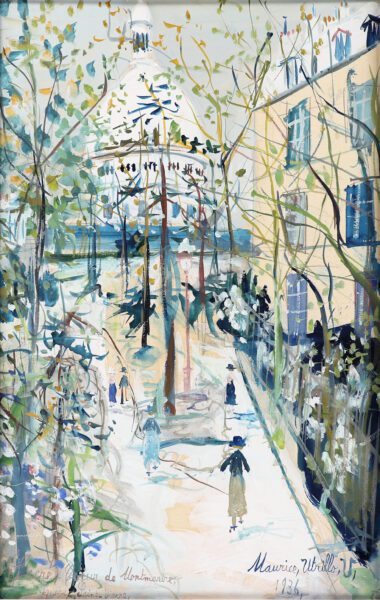“Sacré Coeur de Montmartre et Square Saint-Pierre”, 1936
Gouache on paper: 48 x 31,3 cm
signed and dated lower right: ‘Maurice Utrillo, V, 1936’
"*" indicates required fields
Notes
Maurice Utrillo’s life could not have been more bohemian. Although a romantic concept nowadays, la vie boheme was far less glamorous in reality back then. His mother, Suzanne Valadon, was a former circus acrobat turned artist’s model and eventually avant-garde artist. In 1894 she became the first woman painter admitted to the Société Nationale des Beaux-Arts. She was only 18 at the time of Maurice’s birth. Utrillo never knew who his father was.
When he was 21 years of age, Utrillo took up painting at the encouragement of his mother, who had learned to paint while posing for artists like Morisot, Toulouse-Lautrec, Renoir and Degas and had become a skillful artist in her own right. Eventually, the two shared a studio in Montmartre. By 1909 Utrillo was painting extraordinary Post-Impressionist street scenes and was exhibiting at the Salon d’Automne in Paris and, by 1912, in the Salon des Indépendants. It was a period marked by a radical bleaching of his palette as white became his predominant tone, and he began mixing paint with glue and lime, producing masterpieces such as La Rue Norvins à Montmartre (c.1910).
By 1910, he had achieved considerable critical acclaim, having developed a style of landscape painting that combined features of Post-Impressionism and Cubism. His landscapes and cityscapes earned him lucrative sales and national notoriety, including the Cross of the Legion of Honor from the French government in 1928. In 1935 he married Lucie Valore (1878-1965), the widow of the art collector and –dealer Pauwels, and moved to Le Vésinet, just outside of Paris, where he drew the present gouache. It has all the characteristics of his later, coloured period, from 1922-1955: lively tones and predominant gays.
Despite having been shunned by the French artistic establishment during much of his career, he is considered one of the pioneers of The School of Paris, the pre-World War I, modern artistic movement characterized by experimentation and pluralism.
Maurice Utrillo produced many paintings of street scenes in the Montmartre district of Paris. He is best known for his White Period (1909–14), during which he used white zinc, sometimes mixed with plaster, to convey the aging walls and deteriorating houses of his cityscapes. Socially withdrawn and a recovering alcoholic, Utrillo would often work from tourist postcards to produce his work.
Provenance
- Private collection, France
- Galerie Hopkins Custot, Paris, 2007
- Private collection, Belgium
- Douwes Fine Art, Amsterdam
Expertise
This work will be included in the Catalogue raisonné of the works by Utrillo currently prepared by Mr Jean Fabris.







